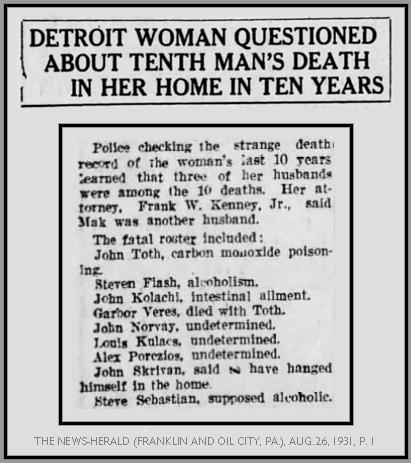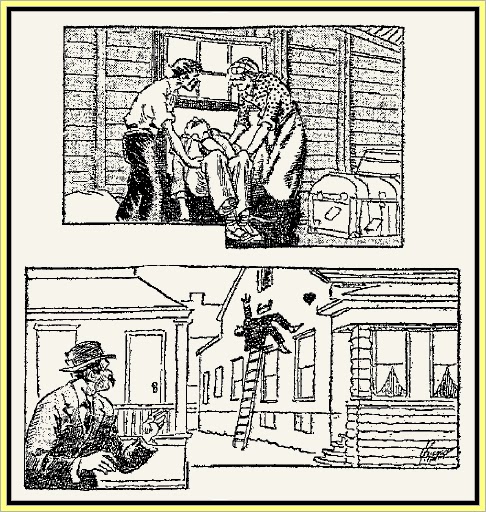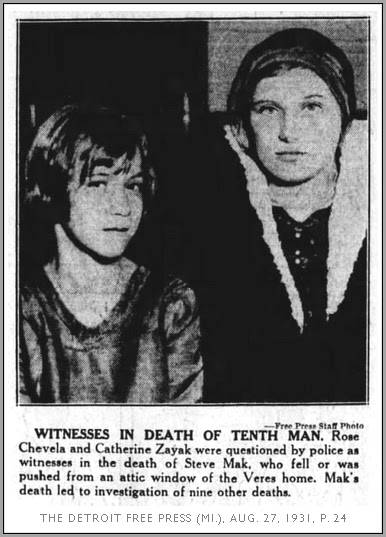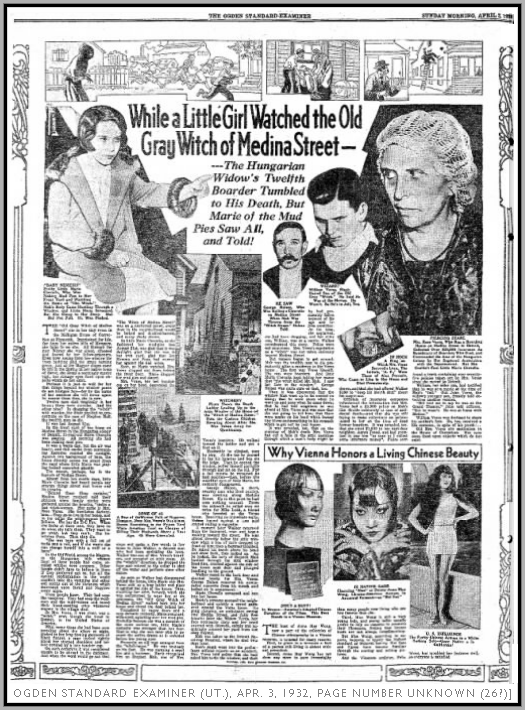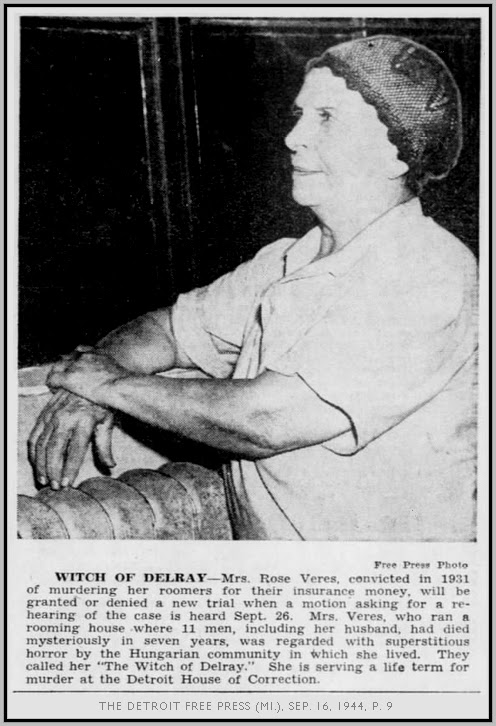[“Witness Says Lodger Pushed From Window,” syndicated (AP), Bluefield Daily Telegraph (W. Va.), Sep. 3, 1931, p. 1]
FULL
TEXT (Article 7 of 9): The “Old Gray Witch of Medina Street” sits in her tiny room in the
Michigan House of Correction at Plymouth. Imprisoned fear life, far from her
native hills of Hungary, she talks to no one. All through the past Winter she
was silent, shunned and feared by her fellow-prisoners. Even now seeing from
her window the trees budding and the grass turning green, just as the Magyar
slopes came to life in the Spring in her native town of Sarud, she keeps a
seemingly mystic vigil, her strange eyes fixed upon objects which do not exist.
Perhaps
it is just as well for her that things beyond her window panes do not intrigue
her, for by the terms of her sentence she will never again be nearer them than,
she is now. Twelve men died, tragically in hear house; three were suicides. And
the other nine? In charging the “witch” with murder, the State decided to
concentrate on the case of Stephen Mak, the twelfth man to die.
It
was last August 21st.
In
the front yard of her home on Medina Street in the Hungarian colony of Detroit,
11-year-old Marie Chevalia was playing. All morning she had been making mud
pies.
It
was a warm day, but the air was heavy, and dull smoke from surrounding
factories resisted the sunlight. Against this background of haze; the house
directly across the street from the yard where little Marie was playing looked
somewhat ghostly.
The
reason, perhaps, lay in the legends of Medina Street.
Almost
from her cradle days, little Marie Chevalia had heard people say strange things
about that house and its inmates.
“Behind
those filmy curtains,” Medina Street mothers told their, .children when family
circles were gathered around the hearths, “stalks a bad witch-woman. Her name
is Mrs. Rose Veres. She bewitches factory men, they go to live in her house,
and in the cellar the witch-woman brews potions. She has the Evil Eye. When she
looks at these men, they have to do when she tells them. They want to go away,
but they can’t. She bewitches them. Then they die.
“She
was born with a full set of teeth and a veil, and if she wants she can change
herself into a wolf or a hare.”
In
the Old World, among the Magyrs, in the Hungarian hills whence most of these
people had come, so-called witches were common. Other people didn’t have to
believe in them if they preferred not to, but all the cynical sophistication in
the world couldn’t take the vampires and other evil spirits out of the darkness
which descended upon Sarud and Nagyrev every night.
These
people knew. They had seen the vampires. They had seen the wolf-men and the
wolf-women and beard their blood-curdling cries whenever anyone in the village
died.
So
Mrs. Veres, it was clear, was a “witch,” even though she lived in Detroit, in
the United States of America.
Why,
many times she had been seen growling about the alleys at might, garbed in her
long flowing garments of black flannel, a cape tucked tightly about her stooped
shoulders and her hair covered by a lace boudoir cap.
On
such occasions it was considered unsafe to be abroad in the darkness. And when
the word would go out that “The Witch of Medina Street” was on a nocturnal
prowl, every door in the neighborhood would be locked and double-barreled, and
every shade drawn.
So
little Marie Chevalia, as she fashioned her mud-pies last August 21st,
was glad that she was in her own yard, glad that it was daylight, glad that she
was in her own yard, glad that her Mamma and Papa had warned her against the
bad witch.
Soon,
as Marie watched, Mrs. Veres stopped out from behind the front door. Marie
dropped her mud pies and stared.
Mrs.
Veres, her net boudoir cap on her head, descended the steps and spoke a few
words in low tones to John Walker, a colored man who had been sprinkling the
lawn. Walker was one of Mrs. Veres’s boarders, and occupied an attic room. At
the “witch’s” direction, he dropped the hose and retired to the cellar to shut
off the water and perform some other duties.
As
soon as Walker had disappeared’ behind the house, little Marie saw Mrs. Veres
pick up a long ladder and place it against the side of the house. Then,
clutching her skirt, beneath which she was accustomed to wear five or six
petticoats, the “Old Gray Witch of Medina Street” walked back into her house
and closed the door behind her.
Transfixed,
by vague fears and a very definite curiosity, Marie remained, wide-eyed,
squatting over her mud pies. Probably because she was a member of the more
curious sex, little Marie’s curiosity was stronger than her fear. That is why
she was later able to recount the entire drama as it unfolded before her young
eyes.
Presently
an old man emerged from the “witch-house.” He was unsteady on his feet. He was
carrying a small box and a hammer. Marie recognized him as Stephen Mak, one of
Mrs. Veres’s boarders. He walked toward the ladder and put a foot on it.
Hesitantly
he climbed, step by step. At the top he paused to lay his hammer and box on the
ledge. Then he opened the window, pulled himself partially through and sat on
the sill. For a full minute he remained in that position – then before the
watchful eyes of little Marie, be suddenly disappeared.
George
Halasz, a short, swarthy man who lived nearby, was strolling along
Medina Street. Up to this point, he had seen nothing unusual. From the sidewalk
he called once or twice for Mike Ludd, a friend who boarded at the Veres house.
Receiving no immediate reply, Halasz leaned against a tree and started rolling
a cigarette.
A
moment later Walker returned from the basement, rear, and began walking toward
the street. He was almost directly below the attic window when a box of nails
dropped in front
of him; then a hammer thudded. He raised his hands above his head and drew
back, then looked up. As he looked, the body of Stephen Mak hurtled through the
attic window head-first, crashed against the side of the house next door and
plunged headlong to the
ground.
Walker
raced to the back door and shouted loudly for Mrs. Veres. George Halasz removed
his newly rolled cigarette from his mouth and looked on in amazement.
Marie
Chevalia screamed and ran into her house.
Marie’s
screams aroused the neighborhood and quickly a crowd gathered around the Veres
home. Its gong clanging, an ambulance swung into Medina Street, and fifty-five
minutes later the ‘Widow Veres” her face noticeably dirty and her head covered
with cobwebs, calmly and inquiringly entered her yard from the alley beyond.
Mak was taken t» the Detroit Receiving Hospital, where he died two days later.
Mak’s
death
went into the preliminary official reports as an accident. Mrs. Veres
told police that she had asked him to fix the window, and that he had
presumably
fallen because of his age and infirm condition. At the time, she
explained, she
had been shopping, and her elder son, William, was at a movie. Walker
corroborated this story. Police were not suspicious. Mrs. Veres’s
reputation as
a “witch” was not taken seriously beyond Medina Street.
But
rumoxs began, to get around. Mak was the twelfth man to die prematurely after a
residence in the Veres house. The first was Veres himself. The. rest were
boarders. And little Marie Chevalia kept telling her mama that “the witch
killed Mr. Mak. I saw her face in the window.” George Halasz was quite sure of
that, too.
Then
it was discovered that the window Mak went up to fix needed no fixing; that he
wore shoes when he went up and none when he came down, that he had told
neighbors he was afraid of Mrs. Veres and was sure that she was going to kill
him; that there were marks on his head which looked like blows; and something
in his stomach which might not be just liquor.
It
was revealed, too, that on the morning of Mak’s death Mrs. Veres had cut a hole
in the attic partition through which a man’s body, might drawn, that
that she had offered Walter $500 to “keep his mouth shut” about his suspicions.
Officials
of insurance companies volunteered the information that Mrs. Veres had a $5,000
policy on Mak’s life, double indemnity in case of accidental death—and that she
was; still trying to make collections on policies issued to her on the lives of
dead former boarders. It was revealed, too, that she owed $1,000 to her
next-door neighbor, Aaron Freed, and had promised to pay him “as soon as I
collect some insurance money.” Police soon found a trunk containing over
seventy-five policies taken out by Mrs. Veres since she moved to Detroit.
William,
her elder son, had testified that he was, at a movie at the time of Mak’s
“fall.” But John Veres, the widow’s younger son, frankly told detectives
another version.
“Bill
told me to say he was at the Grand Theatre,” John told officers. “But he
wasn’t. He was at home with Mother.”
William
Veres was destined to share his mother’s fate. He, too, received a life
sentence, in spite of his youth. Old Mrs. Veres sits motionless in the House of
Correction. ‘Her eyes’ seem fixed upon objects.
[“While
a Little Girl Watched the Old Gray Witch of Medina Street – The Hungarian Widow’s Twelfth Boarder Tumbled to His Death, But Marie of the Mud Pies Saw All, And Told!”
Ogden Standard Examiner (Ut.), Apr. 3, 1932, page number unknown]
***
FULL TEXT (Article 7 of 8): At lost
relentless justice has been meted out to America’s most cold-blooded woman
killer – Mrs. Rose Veres, known as the Witch of Delray. She was responsible for
the deaths of 12 lodgers – simple Hungarians whose lives she had insured.
FREEDOM’S door has been slammed on
the Witch of Delray.
The air she breathes for the rest of
her days must be screened through prison bars.
There will be no recapture of the
years when she roamed the streets of Detroit, frightening children and killing
men.
The Witch of Delray, who actually is
Mrs. Rose Veres, murdered for profit, which is why she was sentenced to life
imprisonment in Michigan.
For a time, while lawyers were
fighting desperately for a new trial for her, it looked as though she might be
free again. But now Recorder’s Judge John J. Maher, at Detroit, has denied her
appeal.
Mrs. Veres made a good thing of being
a witch. She got away with it for seven years, during which time she became a
legendary figure in black, and by the time the law caught up with her the
number of her victims was reckoned at 12. Her bank-deposits for the period
totalled £23,000.
DASTARDLY PLAN
She worked out a simple plan for
living by the death of others. She took a rooming house in the Delray section
of Detroit, where most of her lodgers were, like herself, Hungarian born. They
were simple folk and Mrs. Veres volunteered to look after their money. At the
same time she insured their lives.
When police got interested in the
goings-on in her home they discovered 75 insurance policies on her boarders, in
all of which she was the beneficiary. She had a reason why.
“I kept insurance policies on most of
my boarders,” she said, “because that is the way my people do. We want a good
funeral. There must be flowers and lodge members. I gave everyone a fine
funeral.”
The police thought too many fine
funerals were being held at the frame dwelling on Medina-street.
ACCIDENTS FAKED
They became curious when Steven Mak,
68, tumbled from a ladder out side the Veres household and died of a fractured
skull. They began asking questions and soon discovered he was the 12th man to
die at the Medina-street house since September 21, 1924, when Steven Sebastian
suffered what was described on the death certificate as a fatal cerebral
haemorrhage.
After a little inquiring in the
neighborhood, detectives found Marie Chevalia, 11, who was making mudpies
outside her home when Mak fell. “I saw Mr. Mak go up the ladder,” she said.
“Mrs. Veres was holding it for him at the attic window. He was right at the attic
window. He swayed and moaned, as if he was sick.”
Her story spun a web around the Witch
of Delray when she added:
“While he was falling, Mrs. Veres and
William (her son) poked their heads out of the window.”
Yes, that was right, Mrs. Veres remembered. She had asked Mak to repair a window. But the police said the window
didn’t need repairs.
Then there was the story of John
Walker. Mrs. Veres, he said, told him to water the ground where the ladder
rested, and the Witch herself placed it on the slippery clay.
And there was £2000 insurance on
Mak’s life.
A jury believed that Mrs. Veres and
her son pushed Mak to death and returned a verdict that provided the maximum
penalty under Michigan law for both – life imprisonment.
Responsibility for the 11 other deaths
wasn’t proved against Mrs. Veres. But the police discovered many strange
circumstances as they delved into her dusty past.
They learned that her husband, Gabor,
and Laszlo Toth, a boarder, were working on a car in the Veres garage one day
in 1927 when suddenly the door slammed. Both died of carbon monoxide poisoning
generated by the automobile exhaust.
EIGHT MEN DIED
They heard about men whose names were
known as John Nordal, Balit Peterman, Gabor Feges, Steven Faish, Alex Porczio,
Berni Kalo, John Sokivon and John Coccardi. All of them slept on wall-lined
cots in the dirt floored cellar.
All of them had casks of wine between
their beds. All of them died. Some said their deaths were caused by lye in the
wine.
While all these things were happening,
Mrs. Veres was becoming known around the neighborhood as a sinister character.
The Detroit district in which she
lived was mainly populated by native born Hungarians – simple folk who still retained many of the
customs and beliefs of the old country.
To them werewolves, human vampires
and witches were very real beings – beings that could do harm to innocent
people who crossed their path.
BRANDED A WITCH
So it is not surprising that locally
the notorious Mrs. Veres should be looked upon by these people as a witch.
That when she appeared, the pious
people should devoutly cross themselves for fear of the evil eye.
Some said she was born with a full
set of teeth and a veil. And some said:
“If she wants, she can change her
self into a wolf or a hare.”
That’s how she became the Witch of
Delray and why she was feared by both adults and children.
Although prison claims her, her spell
continues.
Almost two years after she was gaoled
John Kampfl, one of her basement lodgers, cut his throat. It was not a critical
wound. Doctors said he would recover.
“No,” he said. “The Witch cast her
evil eye on me.”
The next morning he died, which
probably isn’t the reason the courts refused her a new trial.
But who knows?
Mrs. Rose Veres murdered ruthlessly
for profit while she was becoming known as the Witch of Delray?
The way the jury figured, William
Veres was as guilty as his mother.
[Gerald Duncan, “America’s Female
Bluebeard Is in Gaol For Life,” World’s
News (Sydney, Australia), Jun. 30, 1945, p. 6]
***
FULL TEXT (Article 9 of 9): Detroit, Mich., Dec. 10 – The
“witch of Delray,” central figure 13 years ago in a murder trial which
ended in her conviction and a life
sentence after bizarre testimony linking her to 11 other deaths, was a free
woman tonight by reason of a “not guilty” verdict in a belated retrial.
She is Mrs. Rose Veres, now 64, who for many years kept a
rooming house and kept a rooming house was a two story frame building in what
was formerly the village of Delray. This community, made up for the most part
of Hungarian and middle European immigrants, is now part of Detroit.
~ Son Convicted, Too ~
At the retrial a jury of eight men and four women took eight
hours to vote an acquittal for the widely known “which,” who was convicted
originally with her son, William, of first degree murder for killing Stephen
Mack, a roomer, by pushing him out an attic window.
Mrs. Veres and her son served 13 years of their life
sentences and recently won new trials on a Supreme court ruling that their
convictions were invalid because of the absence from the courtroom of the
presiding judge when the verdict was returned.
~ Courtroom is Packed. ~
When the new trials were ordered, prosecuting authorities
released William Veres to stand trial again. The retrial began Nov. 26 before
Recorder’s Judge Paul E. Krause, and each day’s session has been in a courtroom
packed with present and former Delray neighbors and residents. Mrs. Veres
speaks no English and testified thru an interpreter.
Evidence was produced at both trials that Mrs. Veres’
rooming house had the local reputation of a “house of dreath” because of the
deaths there of 11 other persons other than Mack between 1924 and 1931.
Children feared her, it was said, because of her long hair and reported
“baleful eye,” and the name “witch of Delray” was applied to her.
When Mack died from a fall from Mrs. Veres’ attick window he
had a $4,000 insurance policy, of which Mrs. Veres was the benedficiary. Police
later found 75 insurance policies in the names of roomers.
[“’Baleful Eyed Witch’ Is Free After 13 Years – Wins In New
Trial Over Old Death Case,” Chicago Tribune (Il.), Dec. 11, 1945, p. 5]
***
EXCERPT: It had been the custom each time one of her roomers
died to have photographs made of the funeral showing her giving the corpse a
final embrace. [Curtis Haseltine, “Murder for Money – Case of Delray’s ‘Witch’
Up Again,” The Detroit Free Press, Aug. 27, 1944, Magazine Section, p. 7]













































